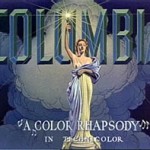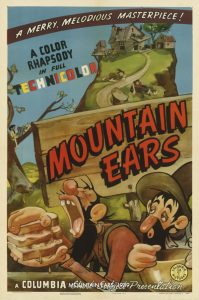My Five Favorite Columbia/Screen Gems ‘Color Rhapsodies’ of the 1930s

The Columbia Color Rhapsodies of the 1930s (like the Fleischer Color Classics, MGM’s Happy Harmonies, and the Warner Merrie Melodies of the era) were a special set of cartoons.
 At first two-color Cinecolor – then 3-strip Technicolor – these cartoons were both competition and an augmentation of Disney’s acclaimed Silly Symphonies. What Disney begat, audiences wanted more – and Disney’s rivals set up to accommodate filling the need (the Disney studio simply couldn’t service the public demand for color cartoons by itself). But Walt had nothing to fear from his friendly competitors – as his sense of story, his artists and animators, his development of new techniques – were way ahead of the pack. The others had to struggle just to keep up with the gang on Hyperion Ave.
At first two-color Cinecolor – then 3-strip Technicolor – these cartoons were both competition and an augmentation of Disney’s acclaimed Silly Symphonies. What Disney begat, audiences wanted more – and Disney’s rivals set up to accommodate filling the need (the Disney studio simply couldn’t service the public demand for color cartoons by itself). But Walt had nothing to fear from his friendly competitors – as his sense of story, his artists and animators, his development of new techniques – were way ahead of the pack. The others had to struggle just to keep up with the gang on Hyperion Ave.
Over at Columbia Pictures, the lower budgeted Charles Mintz Color Rhapsody shorts (pre-1940) did their darnedest to keep pace – and you’d think this would be an easy TOP 5 list to compile. But you’d be surprised – it was not. Beyond my top two – bonified classics in my opinion – selecting the rest was a bit of a struggle.
Once established, the Rhapsodies quickly fell into formula. There were the musical pagents (Let’s Go, Animal Cracker Circus, etc.), fairy tales or fables (Shoemaker and The Elves, A Boy and His Dog, etc), Hollywood caricature spot gags (Gifts From The Air, Hollywood Picnic, etc) and cartoons that combined all of the above (Mother Goose In Swingtime for example). Not that there’s anything wrong with that – but these basic plots were a shorthand that eventually became cliché.
So let’s take a look at my choices. You might notice that the first Color Rhapsody, Holiday Land, is not there; neither is a fan favorite, Iwerks’ The Horse On The Merry-Go-Round. Remember these lists are subjective. Change my mind – send in your TOP 5 list to the Comments below. Only 1930s cartoons please (Post 1939 the Color Rhapsodies do change into another animal – a Fox and a Crow in particular).
1. THE LITTLE MATCH GIRL (1937) Story: Sid Marcus. Animation: Art Davis
Perhaps the best Columbia cartoon – and the first from the studio to be nominated for an Academy Award. An abbreviated retelling of Andersen’s famed fairy tale, sans dialogue, lavishly illustrated and pulling no punches – with the heart breaking finale remaining intact.
2. MERRY MANNEQUINS (1937) D: Ub Iwerks.
The Iwerks cartoons released by Columbia during the late 30s are all very good, all have something worth a look (like the work of that still unidentified background painter who adorns The Foxy Pup and The Horse On The Merry Go Round) or a listen (Mel Blanc – and/or some very catchy songs). Merry Mannequins is a stand out – both for being one of the few “Art Deco” cartoons of the era (alongside Avery’s Page Miss Glory and Fleischer’s All’s Fair At The Fair) – and for the wonderful original tune (“Getting Chummy With A Dummy Like You”). Just a delight.
3. BON BON PARADE (1935) Story: Ben Harrison. Animation: Manny Gould.
A quintessential “candy-on-parade” cartoon – perhaps the first from the studio (Screen Gems apparently loved doing ‘parade’ cartoons – loaded with lots of cycles, which helped keep the budgets low). No, that’s not Scrappy – but they earn extra points for the Three Stooges cameo – and the appearance of Santa – and the colorful fireworks ending. Pure “eye-candy” from beginning to end.
4. GLEE WORMS (1936) Story: Ben Harrison. Animation: Manny Gould.
I just like this one because it’s so archetypical, almost a perfectly generic 1930s cartoon. I’m also a sucker for the song Glow Worm. It’s so sincere and cute. Just a personal fave… nothing more than that.
5. MOUNTAIN EARS (1939) Director: Manny Gould. Animation: Ben Harrison.
Okay – I’ve had a 16mm Technicolor print of this one for years. I’ve always liked showing it to others. It’s trying hard to be an Avery travelogue; it breaks the fourth wall; and that Jack Lescoulie narrator (a cross between Jack Benny and Pete Smith – note the reference to Prudence Penny, a homemaker featured in several Smith Specialties). Love the extended bit with the giant hands trying to grab the bratty kid at the end. Just a favorite.
Now it’s your turn. Tell me which Color Rhapsodies (from the 1930s) are your favorites and why.
